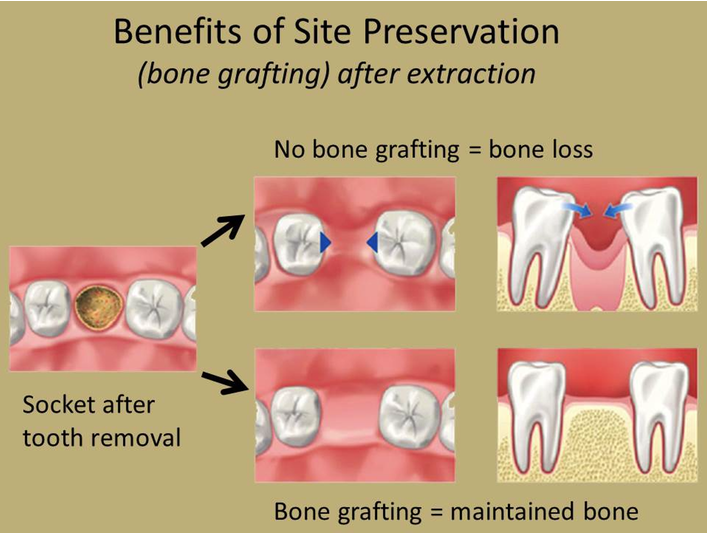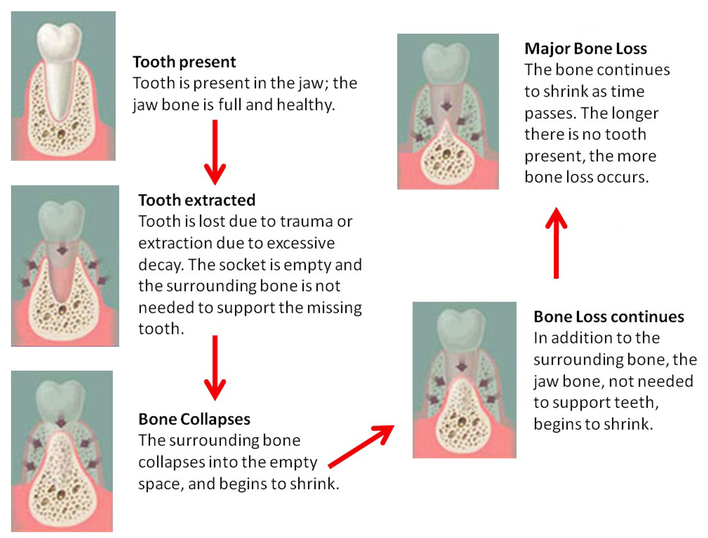Socket Preservation
What Happens After The Tooth Extraction?
After tooth extraction, the alveolar ridge will commonly decrease in volume and change morphologically. These changes are usually clinically significant and can make tooth replacement challenging in the aspect of achieving best aesthetic and functional results. The degree of residual ridge resorption is closely related to the time since tooth extraction in both maxilla and mandible. The loss of bone volume is greatest in the early post extraction period. The width of the alveolar ridge decreases ~50% and two-thirds of the reduction occurred within the first 3 months. If bone resorbtion is significant enough, then placement of an implant may become extremely challenging. Post-extraction maintenance in form of socket perservation of the alveolar ridge minimizes residual ridge resorbtion and thus optimal aesthetic and functional results can be achieved with conventional bridge or implant or partial or denture when restoring a missing tooth.
What Happens During Socket Preservation?
Socket preservation is a type of bone grafting procedure designed to preserve the alveolar ridge and protecting the tooth socket from inevitable bone erosion/bone loss. In addition, socket preservation can also correct or amend any deformity that may exist in the alveolar ridge or socket. This procedure is done at the time of the tooth extraction. In doing so, it creates a stronger support system for the dental implant that will be put into place at the same site in the near future.What Happens During Ridge Augmentation?
Ridge Augmentation is a type of bone grafting procedure designed to correct or amend any deformity that may exist in the alveolar ridge due to extraction of the tooth long time ago.
Grafting Materials
Recent advances in bone grafting materials and techniques allow Dr. Patel to place implants in sites that were considered compromised in the past. Dr. Patel uses different types of grafting materials for guided bone regeneration based on clinical findings and situation.- Autogenous graft (autograft) material is transferred from one position/area to deficient area within the same individual. Graft may be intraoral or extraoral depending on the site of harvest.
- Allograft material is transferred from a donor of the same species. The most common grafts are freeze-dried bone grafts, which may be mineralized or demineralized.
- Xenograft material is transferred from a donor of another species, processed appropriately. Primarily porous de-proteinized bovine bone mineral.
- Alloplast synthetic material, usually inert, used as a substitute for bone graft to maintain space.
- Resorbable membrane which is very thin tissue harvested from donor’s heart.
- Non-resorbable membrane which is synthetic membrane that does not resorb and patient will have to go back for follow up for removal of it.
- Platelet Rich Fribin (L-PRF) is basically a bioactive “band-aid” that is created from your own blood then placed in your surgery site(s) to promote healing. A sample of your blood is collected in a tube, just as it would be for a blood test. Dr. Patel then uses the unique IntraSpin™ System to separate and concentrate certain important cells and active proteins by spinning your own blood in a dedicated centrifuge. After a fast preparation the bioactive clot, created just from your own blood, is now ideal for your procedure. Membrane is used to protect the bone grafting material in socket preservation or ridge augmentation during initial healing period to prevent epilethial proliferation.


